Seven months after Pearl Harbor, with the United States finally joining the war that has been raging in Europe for two years, the atmosphere of wartime has become a major element in Church culture, too. Thousands of young Mormon men have been called into the service, and the Church is scrambling to set up organizations to provide worship opportunities and emotional and spiritual support for these young men away from their usual networks, and to reassure the people at home that the Lord was in control of events which called for the best behavior and efforts of every member.
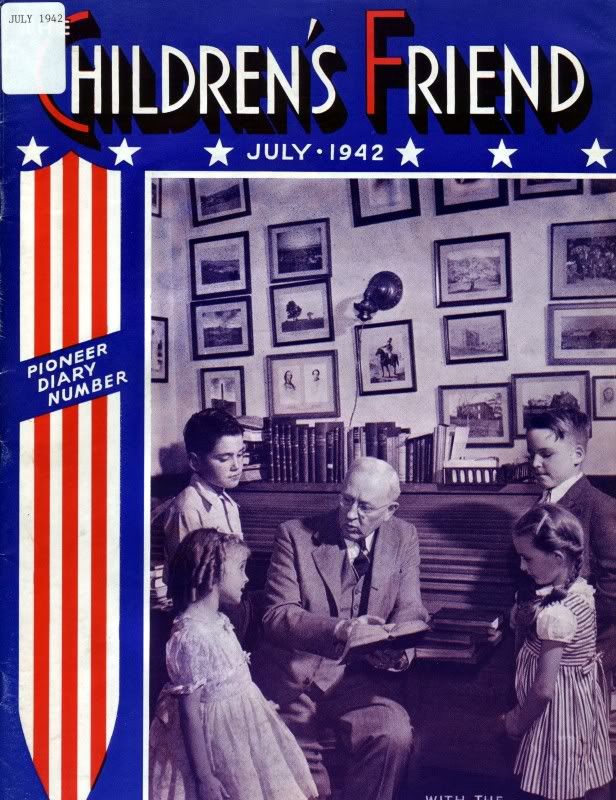 The Children’s Friend featured a patriotic cover, together with a photograph of Church Historian/Apostle Joseph Fielding Smith talking with children. Inside the magazine, the major article – one much longer than most articles in the Friend’s tradition, spoke of “Honoring the Pioneers Through Diaries of Long Ago,” and included many pages of excerpts from pioneer diaries.
The Children’s Friend featured a patriotic cover, together with a photograph of Church Historian/Apostle Joseph Fielding Smith talking with children. Inside the magazine, the major article – one much longer than most articles in the Friend’s tradition, spoke of “Honoring the Pioneers Through Diaries of Long Ago,” and included many pages of excerpts from pioneer diaries. 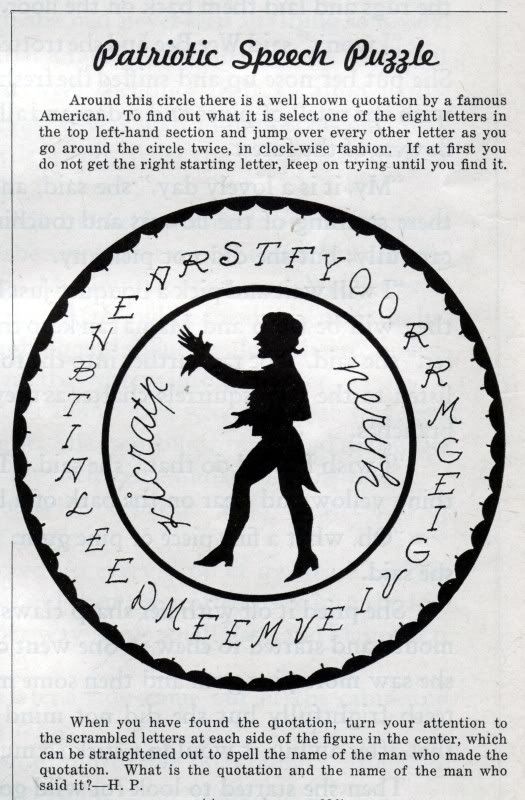 There was also the announcement of a story-writing contest; suggestions for making a scrapbook of leaves; directions for crafting a bedspread and a wooden shoe rack; and this Independence Day-themed puzzle. In that era, the Friend included sections aimed at teachers and parents; this issue featured such an article on the importance of milk to a child’s nutrition, with suggestions on how to incorporate more milk into a child’s diet beyond simply drinking it as a beverage.
There was also the announcement of a story-writing contest; suggestions for making a scrapbook of leaves; directions for crafting a bedspread and a wooden shoe rack; and this Independence Day-themed puzzle. In that era, the Friend included sections aimed at teachers and parents; this issue featured such an article on the importance of milk to a child’s nutrition, with suggestions on how to incorporate more milk into a child’s diet beyond simply drinking it as a beverage.
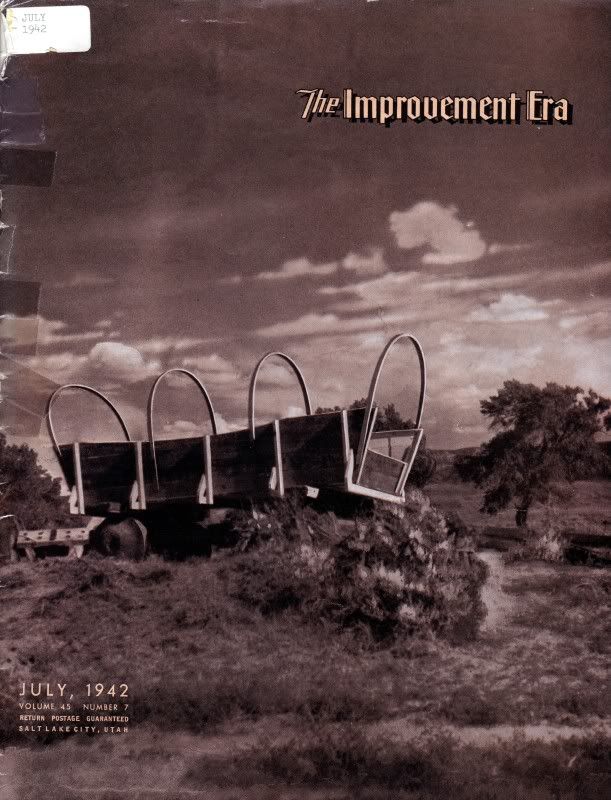 Because it was July, The Improvement Era carried an article on Utah’s first Pioneer Day celebration. A major article, framed in wartime symbolism, was entitled “Spiritual Re-Armament and Moral Defense: The Crying Need of the Hour.” A Red Cross nurse who had served in France aiding the Belgian refugees pouring across the border told of terrified people, around-the-clock labors, and heartbreaking personal stories. One woman would not let the nurse take her three children away from her even to give the mother a brief rest – “No, leave them here – close,” she insisted. As the nurse bandaged a wound in the mother’s head, the woman said:
Because it was July, The Improvement Era carried an article on Utah’s first Pioneer Day celebration. A major article, framed in wartime symbolism, was entitled “Spiritual Re-Armament and Moral Defense: The Crying Need of the Hour.” A Red Cross nurse who had served in France aiding the Belgian refugees pouring across the border told of terrified people, around-the-clock labors, and heartbreaking personal stories. One woman would not let the nurse take her three children away from her even to give the mother a brief rest – “No, leave them here – close,” she insisted. As the nurse bandaged a wound in the mother’s head, the woman said:
It is nothing, nothing but a splinter of shell. I fled with my little ones. Everything around us was in flames. We ran and ran … Suddenly I remembered … I had forgotten my little baby – four months old – in his cradle – in a bedroom – high up … I could not go back – and so I went on – I had to go on to save these three.
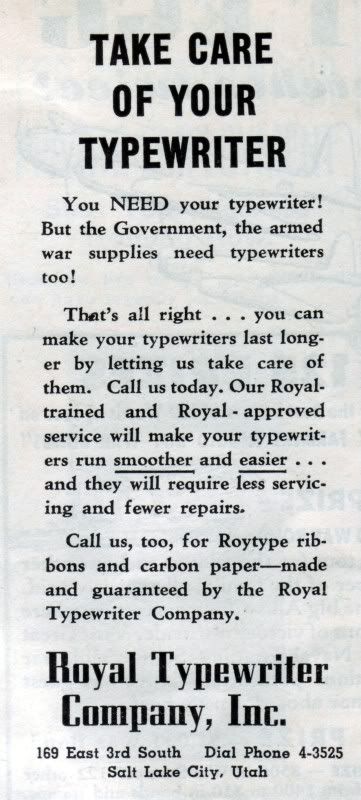 Even the advertisements were flavored by war, with pitch after pitch being made for products or services to extend the life of materials that would become ever more scarce during the war years – tires, building materials, cars, farm machinery, even typewriters.
Even the advertisements were flavored by war, with pitch after pitch being made for products or services to extend the life of materials that would become ever more scarce during the war years – tires, building materials, cars, farm machinery, even typewriters.
All was not tinged by the horrors of war, however; the joke pages continued:
Mrs. A.: I suppose you carry a memento of some sort in that locket of yours?
Mrs. B.: Yes, it is a lock of my husband’s hair.
Mrs. A.: But your husband is still alive.
Mrs. B.: Yes, but his hair is gone.
and this one:
Groom: How did you make this cake, dear?
Bride: Here’s the recipe. I clipped it from a farm magazine.
Groom: Are you sure you read the right side? The other side tells how to make a rock garden.
Ba-da-boom!
 The Instructor discussed the challenges of maintaining peak Sunday School efficiency in wartime, subject as they were to “rapid and sweeping changes.”
The Instructor discussed the challenges of maintaining peak Sunday School efficiency in wartime, subject as they were to “rapid and sweeping changes.”
The importance of religion to the soldier is stressed frequently, mainly by soldiers themselves. It is equally important to the morale of the civilian, who must bear the burden of the times in other arduous ways.
Sunday Schools are doing an admirable job of morale building in the communities and homes of civilians and in innumerable military centers. The men in camps attend religious service with solemn fervor and longing. …
The defense industries operating on war time schedules employ large numbers of people from Sunday School classes and organizations of officers and teachers. The shifts these people must work often keep them for a week or more from attending Sunday School.
Many rural Sunday Schools have been affected by the men leaving for military service or to take employment in defense areas. Women working in defense occupations are similarly withdrawn from Sunday School service.
Hardly a school exists which has not been affected to some degree.
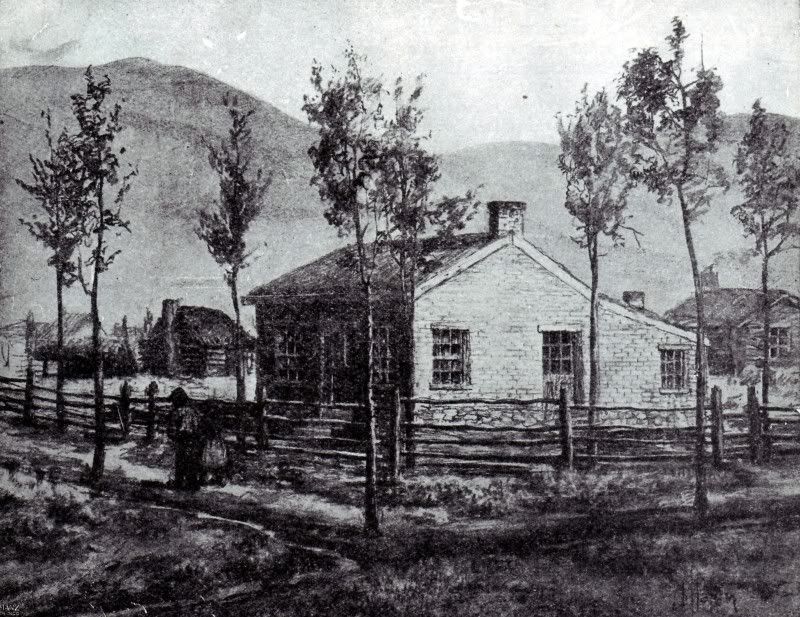 The Instructor encouraged members by reminding them of the heritage of Sunday Schools in the Church, celebrating the early organization of Schools in the Church both with a cover design depicting the first such School organized by Richard Ballantyne, and with an article on the history of the Schools.
The Instructor encouraged members by reminding them of the heritage of Sunday Schools in the Church, celebrating the early organization of Schools in the Church both with a cover design depicting the first such School organized by Richard Ballantyne, and with an article on the history of the Schools.
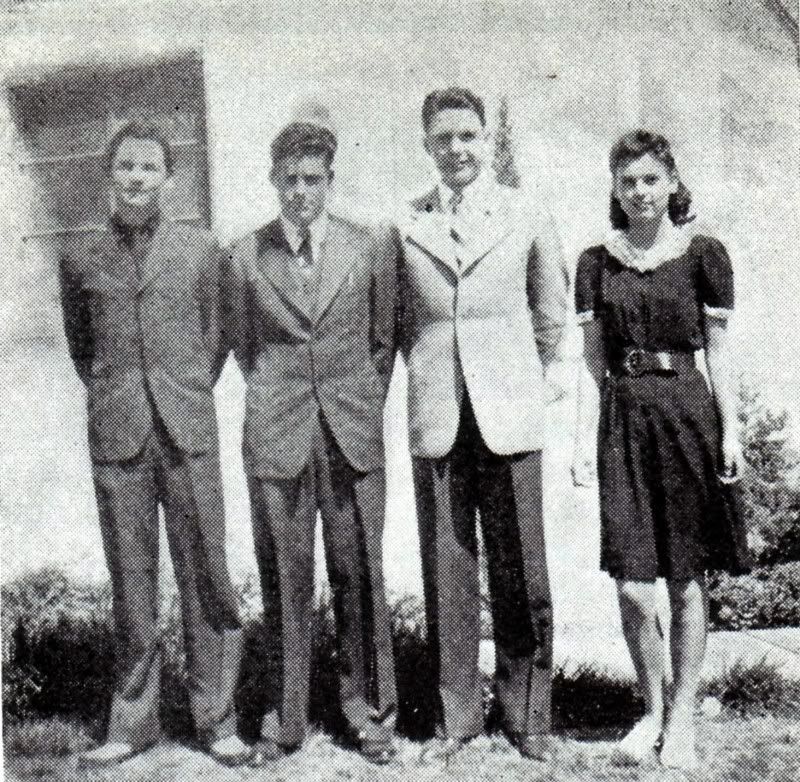 The magazine also noted some of the adaptations made in order to keep Sunday Schools functioning, such as the calling of the youngest ward Sunday School superintendency in the Church, in Bryce Ward, St. Joseph (Arizona) Stake. Those officers, pictured here, were Superintendent Hollis Hancock, 18; First Assistant Roy Beach, almost 17; Second Assistant Ray Hancock, 17; and Secretary Vona Dixon, 15.
The magazine also noted some of the adaptations made in order to keep Sunday Schools functioning, such as the calling of the youngest ward Sunday School superintendency in the Church, in Bryce Ward, St. Joseph (Arizona) Stake. Those officers, pictured here, were Superintendent Hollis Hancock, 18; First Assistant Roy Beach, almost 17; Second Assistant Ray Hancock, 17; and Secretary Vona Dixon, 15.
The Sacrament Gem repeated by members throughout the month was a hymn verse:
God, our Father, hear us pray,
Send Thy grace this holy day;
As we take of emblems, blest,
On our Savior’s love we rest.
The practice hymn was one in our current book (under a slightly different title — “The Happy Day at Last Has Come”) and that had first appeared in our hymnal in 1840, “The Happy Day Has Rolled On.”
The happy day has rolled on,
The glorious period now has come;
The angel sure has come again
To introduce Messiah’s reign.The Gospel trump again is heard,
The truth from darkness has appeared;
The lands which long in darkness lay
Have now beheld a glorious day.The day by prophets long foretold,
The day which Abraham did behold,
The day that saints desired long,
When God his strange work would perform.The day when saints again should hear
The voice of Jesus in their ear,
And angels who above do reign
Come down to converse hold with men.
Communications with Church members in the war zones had become very sporadic, but during this month Thomas E. McKay, president of the European Missions (although he had been forced to return to Utah) received word from the Armenian members in the Church’s branches in Syria. Abraham Hindonian, in charge of the Church there, wrote:
All members are in good condition in present time, but wheat that we bought a year ago finished and much in need of wheat and life is hard to live but we only trust to Lord and prayers from ZION and all is be well. … As far as we can we carry on in Gospel and all Saints in good standing in faith. … Remember us to missionaries that was in this land doing splendid work. … Your brother in the Lord, ever.
President A.K. Anastasion of the British Mission sent in his report, too, telling Church leaders of the family of John Cook, whose home had been destroyed by an incendiary bomb. The local members were aiding them with what supplies they could furnish, and “Brother Cook, being a genealogist, is delighted that all his records and papers have been preserved.” President Anastasiou also report his efforts to encourage members not to scatter to distant parts of the country, but to gather to areas where the Church was established so that they could maintain their ties to the Church and lend their support to other members.
Elder John R. Alley of Lihue, Hawaii also wrote to remind the Church of the “great danger of forgetting that all the races of the earth are children of God and brothers and sisters to each other … there are members of all races united under the Gospel banner, with the same ideals and purposes in life,” and enclosing a photograph of the young Japanese members of his branch.
No reports were received from the Saints in Germany or in occupied countries of Europe.
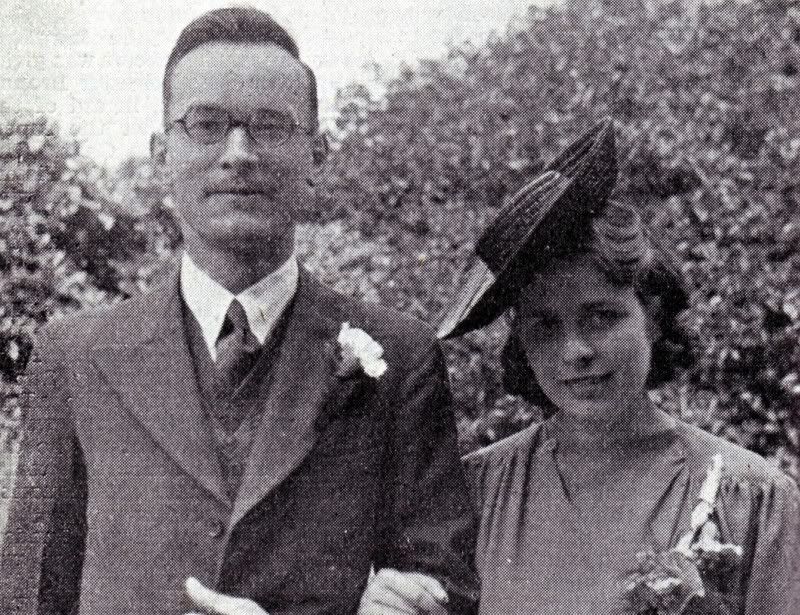 In Southampton Branch, England, members celebrated the recent wedding of two of their own young people: Henry C. Squire and Henrietta Martin. Both young people were home missionaries, helping to carry on the work of teaching the gospel in the absence of the usual full-time missionaries, and had met at a mission conference. Following a brief honeymoon, the couple settled into married life at Aldershot, where Brother Squire was the branch president.
In Southampton Branch, England, members celebrated the recent wedding of two of their own young people: Henry C. Squire and Henrietta Martin. Both young people were home missionaries, helping to carry on the work of teaching the gospel in the absence of the usual full-time missionaries, and had met at a mission conference. Following a brief honeymoon, the couple settled into married life at Aldershot, where Brother Squire was the branch president.
Families visited by their ward (home) teachers during the month discussed this message:
In the early days of the Church the General Authorities and members were targets for the bitterest persecution and criticism. This ill treatment, however, came, for the most part, from those not of the Church. For strength against these attacks the Latter-day Saints became united as one man in their efforts for preservation and liberty. They sought and followed the counsel of the leaders of the Church whom they sustained as the chosen oracles of God. Out of these tribulations the mighty strength of the Church was developed.
The Church today, however, is again face to face with criticism and fault finding. This time, however, they are all the more harmful and unbecoming, since, in a great many cases they come from those within the Church. This is sad indeed. The most pitiful thing is that this critical attitude on the part of members of the Church is as a mill-wheel slowly grinding away their testimonies of the truth.
There is no power on earth that can disrupt or destroy the Church. It is God’s work, and it will fulfil its ultimate destiny. What a great satisfaction it is to unreservedly sustain and uphold those called to direct the onward progress of this sacred institution. How noble to pray ever humbly before the Lord for the inspiration and guidance of His leaders. How admirable to follow their counsel and thus demonstrate our devotion and loyalty to the Most High, and our worthiness to be Latter-day Saints.
The policies, decisions, and counsels of the leaders of the Church are inspired. The mind and will of the Lord is given through His chosen servants. Time has vindicated their judgments, and demonstrated beyond all doubt that what the Lord gives through our leaders is for our blessing and exaltation. We stand in our own light when we assume to set aside the counsels of God thus given for our guidance.
Let there be unity and full support coming from Church membership. God is guiding His leaders; the wise and prudent will follow their counsel.
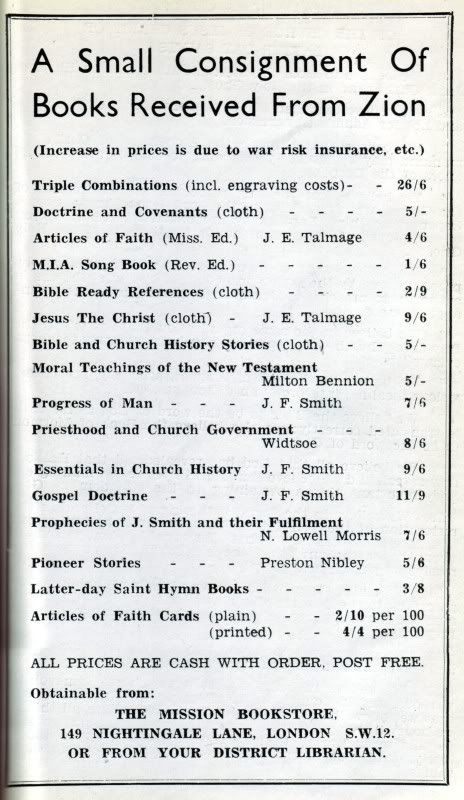 War conditions affected even the materials available to the British Mission, but the Millennial Star announced the availability of a “small consignment of books received from Zion.”
War conditions affected even the materials available to the British Mission, but the Millennial Star announced the availability of a “small consignment of books received from Zion.”
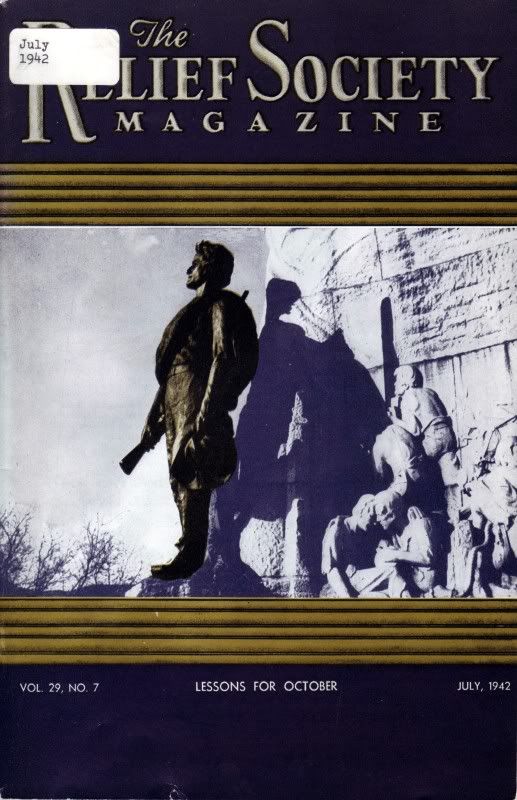 July was a happy month for the Relief Society, because the design of the Relief Society monument (the campanile, or bell tower, now on Temple Square) was coming together. Photos of the completed design for three of the four bronze plaques to surround the campanile’s base, depicting various activities of the Relief Society, were received in Salt Lake.
July was a happy month for the Relief Society, because the design of the Relief Society monument (the campanile, or bell tower, now on Temple Square) was coming together. Photos of the completed design for three of the four bronze plaques to surround the campanile’s base, depicting various activities of the Relief Society, were received in Salt Lake.
The decision was also made by Church authorities that the tower would not be completed at that time: “Although the monument was begun before the war started and all materials were secured before the government restrictions, it is explained the decision to postpone erection is in harmony with the government’s war program.” The campanile would not be constructed until the 1960s, and even then under protest by several Church authorities. Tastes had changed, and the tower’s “oriental” design was deemed “ugly” by some apostles.
Nevertheless, in July 1942, the Relief Society was pleased by the design and eager for its construction, especially because it was to be crowned by the installation of what was then believed to be the original bell from the Nauvoo Temple, but which has since been discovered to have been another bell entirely (one stolen, in fact, from an Iowa church and sold to Brigham Young after it had been freighted across the plains; the bell remained in Salt Lake even after its true owners identified and claimed it – Brigham Young offered repeatedly to return it to them, with his standing the loss of the amount he had paid, but he insisted that the Iowa church pay the cost of freighting the bell back across the plains, which they never managed to do). Still, the belief that the bell was the Nauvoo Temple bell was so strong in 1942 that the Relief Society Magazine carried a poem dedicated to the bell.
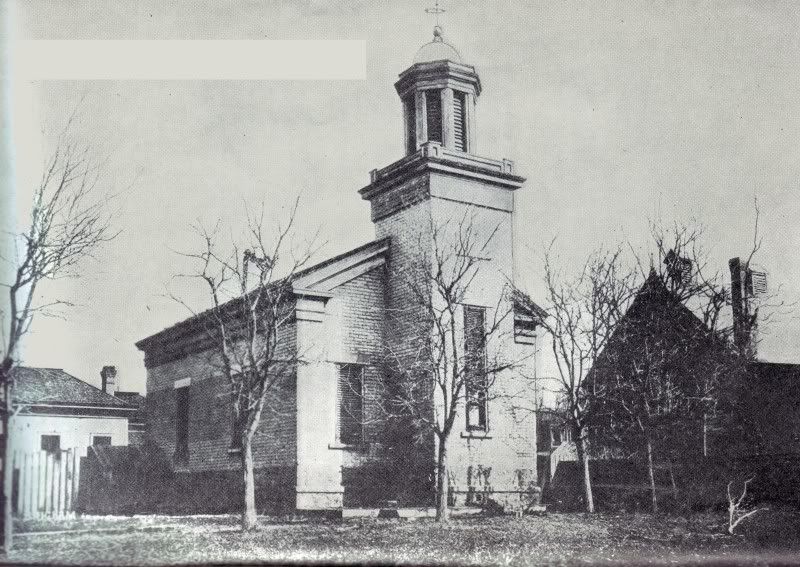 The Relief Society Magazine that month also carried an article, in honor of Pioneer Day, on early education among the Saints in Utah, illustrated by a photograph of Brigham Young’s schoolhouse (formerly standing on the other side of Eagle Gate from the Beehive House), and, in keeping with the war themes so prevalent in the magazines that summer, there was an article on “Preserving Our Homes in Wartime”:
The Relief Society Magazine that month also carried an article, in honor of Pioneer Day, on early education among the Saints in Utah, illustrated by a photograph of Brigham Young’s schoolhouse (formerly standing on the other side of Eagle Gate from the Beehive House), and, in keeping with the war themes so prevalent in the magazines that summer, there was an article on “Preserving Our Homes in Wartime”:
We have long known that an unpleasant atmosphere at home affects morale more seriously than does anything else. One of our first rules for maintaining morale, then, should be to call a truce in all family differences. If for no other reason, we should now unite our forces because we have a common enemy. Surely with deadly foes working and praying night and day for our destruction, we have no spare energy to fight each other in the home.
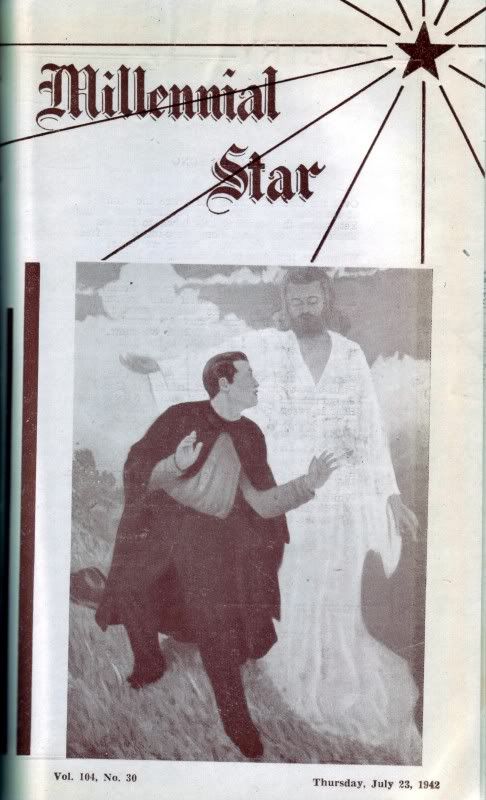 The Millennial Star continued its weekly publication schedule in Britain despite wartime conditions. The magazine during that period carried little but reprints from Utah journals, plus mundane minutes of local conferences, with a few notes on branch and mission activities. Still, it was a regular, cheerful messenger to the Saints in Britain, and elsewhere. The issue for July 9 carried the sad note that an earlier copy mailed to member A.A. Butler in Malaya had been returned, marked “Addressee Reported Missing.”
The Millennial Star continued its weekly publication schedule in Britain despite wartime conditions. The magazine during that period carried little but reprints from Utah journals, plus mundane minutes of local conferences, with a few notes on branch and mission activities. Still, it was a regular, cheerful messenger to the Saints in Britain, and elsewhere. The issue for July 9 carried the sad note that an earlier copy mailed to member A.A. Butler in Malaya had been returned, marked “Addressee Reported Missing.”
Brother Butler has been in the Far East almost from the commencement of the war and wrote regularly to the Headquarters of the Church in London and to his many friends until Singapore fell. He must have been taken prisoner with many thousands of our British soldiers there.
In his letter dated January 12th, 1942, he wrote: “It is some time since I saw any of you – almost two years. Since that time I have gone through some very strange experiences, but I have always known that the prayers of the Saints have been with me. It has been a great comfort to have this assurance. Now that the war has come to this part of the world, I shall need those prayers more than ever before.
“I have experienced many thrills in my life, but I am quite convinced that one of my greatest is yet to come. My belief is that it will be when I return to London – to Ravenslea – and meet all the Saints again, and sing from the stand to all of you again. it was always such a pleasure to do this, for I knew how greatly you all appreciated my effort.”
We cherish the hope and fervently pray that our Brother is well and will soon return home to us.
We were a much smaller Church in those days – just over 900,000 members. With Heber J. Grant as Church president, and counselors J. Reuben Clark, Jr., and David O. McKay, we fielded a missionary force of only 629 (down from 1257 the year before, but still more than the low point of 261 in 1943), with only 143 stakes in 37 missions. The Quorum of the Twelve Apostles included George Albert Smith, George Franklin Richards (who was also acting patriarch), Rudger Clawson, Joseph Fielding Smith, Stephen L Richards, Richard R. Lyman (who would be excommunicated and dropped from the Quorum in a matter of months), John A. Widtsoe, Joseph Francis Merrill, Charles A. Callis, Albert E. Bowen, Sylvester Q. Cannon, and Harold B. Lee. Amy Brown Lyman was Relief Society president; Lucy Grant Cannon directed the Young Women; and May Green Hinckley led the Primary.
The Idaho Falls Temple was nearing completion, with landscaping and interior decorating underway, but it would not be dedicated until 1945. In July 1942, the only functioning temples were those at Salt Lake City, St. George, Logan, Manti, Laie (Hawaii), Cardston (Alberta, Canada), and Mesa (Arizona) – imagine, only seven temples!
The Book of Mormon was available in only a handful of languages: English, Danish, German, French, Italian, Welsh, Hawaiian, Spanish, Swedish, Maori, Dutch, Samoan, Tahitian, Turkish, Japanese, Czech, Armenian, Portuguese, and English Braille. The next to be printed would be the Tongan edition, completed in 1946.
And in the midst of all of this, another — personal — event of great importance to one Keepa reader occurred, which s/he is welcome to disclose, or not, at his/her discretion.
Continue reading at the original source →



